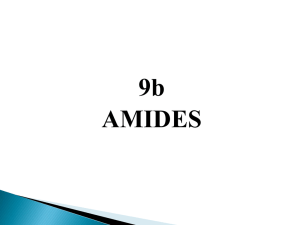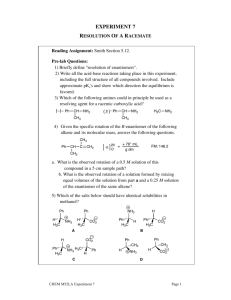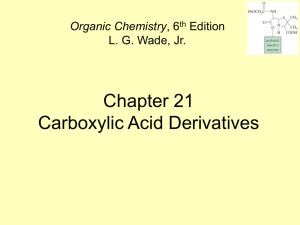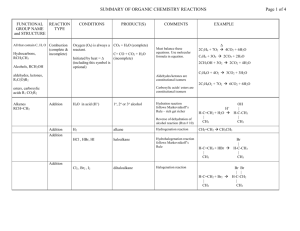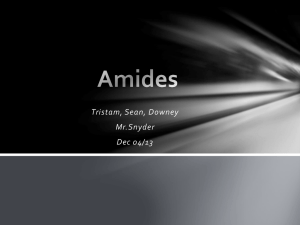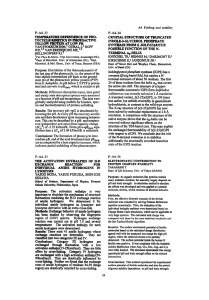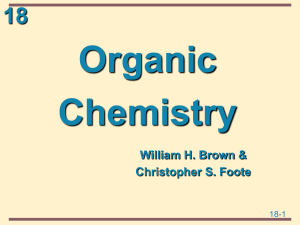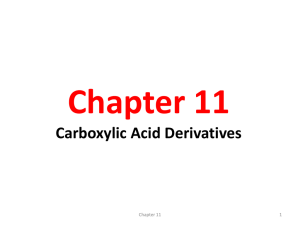Chem 30CL-Lecture 7b..
advertisement
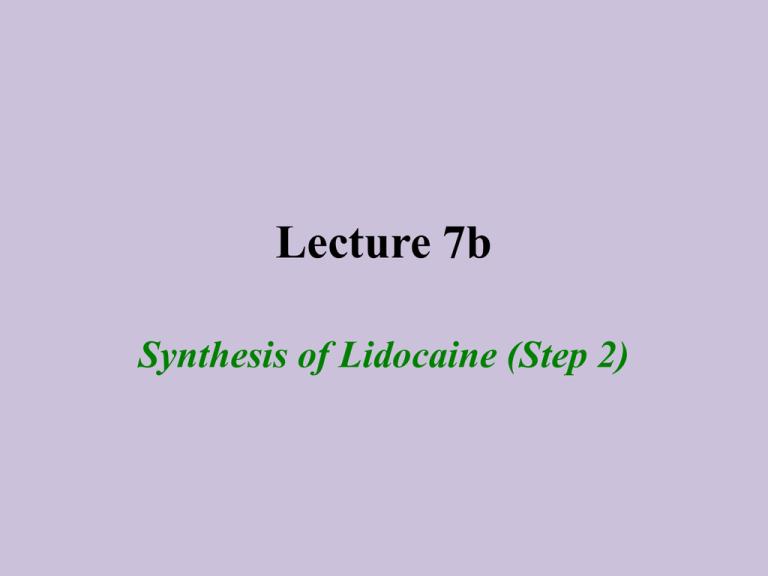
Lecture 7b Synthesis of Lidocaine (Step 2) Introduction • Amides play a very important role in biochemistry, pharmaceuticals and materials - OOC • Peptide bonds i.e., the Aspartame (Nutrasweet) which is the methyl ester the dipeptide of L-aspartate and L-phenylalanine • Penicillin G is a tripeptide formed from L-aminoadipic acid, L-cysteine and L-valine • Polymers H N + H3N O OCH3 O H H H N S O N O CH3 CH3 COO-K+ • Nylon 6,6: Y=Z=(CH2)4 • Kevlar: Y=Z=p-C6H4 • Both of them are homopolymers Kevlar Formation of Amides • Most acid derivatives are more reactive than amides and can be used as reactants O O • Ester + ammonia + • Byproduct: alcohol + • Byproduct: salt O NH2 R O O O R R R O + R2NH2+ RCOO - + R'OH NR2 O + R 2NH OR' R • Acid + amine • Byproducts: first a salt, then water R'OH + 2 R 2NH • Ester + sec. amine • Byproduct: alcohol OR' R • Anhydride NH3 R NR2 O + R OH R NH2 RNH3+ RCOO - O T R NHR + H2O Theory of Amide Formation I • In the lab, an acyl chloride is used as carboxylic acid source • Advantages: • It possesses a high reactivity in chemical reactions, which can be carried out under milder conditions i.e., Schotten-Baumann esterification • The higher reactivity is due to a better leaving group (chloride) • The carbonyl group is very electrophilic due to the inductive effect of chlorine, which is a poor resonance contributor due its larger size compared to carbon resulting in a poor overlap of the 2p-orbitals of carbon with the 3p-orbitals in chlorine • Disadvantages: • They are more difficult to handle due to their tendency to hydrolyze in air O O Cl + H2O Cl Cl OH + HCl Theory of Amide Formation II • In the lab, a-chloroacetyl chloride is used because it has two functional groups - O NH2 H3C O Cl Cl H2N + O CH3 + H2N Cl Cl H3C CH3 H3C O Cl CH3 Cl- HN NaCH3COO H3C Cl CH3 soluble in HOAc • The amine function reacts preferentially with the acyl chloride over the alkyl chloride because the acyl carbon is much more electrophilic • The protonated form of the amide is soluble in acetic acid • The acetate ion is able to deprotonate the protonated form of the amide (pKa= ~ -1) but not the ammonium salt (pKa= ~ 4) • The neutral form of the amide is weakly polar and insoluble in aqueous acetic acid Experimental (Step 2, Part I) • Dissolve 2,6-xylidine in glacial acetic acid • Why is glacial acetic acid used here again? To minimize the water in the system • Add 1.1 equivalent of the acyl chloride • What does 1.1 equivalent refer to? To the number of moles of the amine • Heat the mixture to 40-50 oC in water bath for 10 minutes • Cool mixture to room temperature • Why is it used in excess? • Which observation is made here? A pink or purple solution • Why is the reaction mixture heated? To increase the rate of reaction Experimental (Step 2, Part II) • Add a 5 % sodium acetate • Why is this solution added? solution To deprotonate the protonated form of the amide • Which observation should the student make here? • Isolate the precipitate by vacuum filtration • Wash the solid with water • Why is the solid pressed? • Press the solid with a stopper while suction is applied as well • Allow the solid to dry in • Why is it important that the solid is very dry? open beaker Water interferes with the lidocaine formation! Characterization I • Melting point • Infrared Spectrum • n(NH)=3214 cm-1 • n(C=O, amide I)=1648 cm-1 • n(CN, amide II)=1537 cm-1 • 1H-NMR n(NH) n(C=O) Spectrum • d(NH)=7.88 ppm • d(CH2)=4.20 ppm CH2 NH n(CN)

